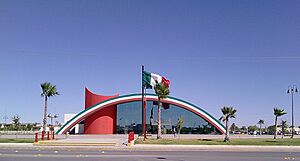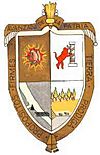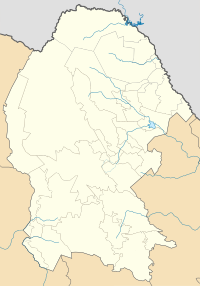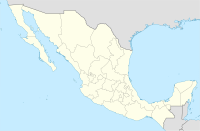Ciudad Acuña facts for kids
Quick facts for kids
Ciudad Acuña
|
||
|---|---|---|
|
City
|
||
 |
||
|
||
| Country | ||
| State | Coahuila | |
| Municipality | Acuña | |
| Settled | 27 December 1877 | |
| Town status | 1880 | |
| City status | 16 September 1951 | |
| Named for | Manuel Acuña | |
| Elevation | 271 m (889 ft) | |
| Population
(2019 est.)
|
||
| • Total | 216,099 | |
| • Demonym | Acuñense | |
| Time zone | UTC−6 (Central (US Central)) | |
| • Summer (DST) | UTC−5 (Central) | |
| Postal code |
26200–26328
|
|
| Area code(s) | 877 | |
Ciudad Acuña (Spanish for 'Acuña City'), or just Acuña, is a city in the Mexican state of Coahuila. It sits right on the Rio Grande river, which is the border between Mexico and the United States. The city is about 271 meters (889 feet) above sea level.
Acuña is connected to Del Rio, Texas in the U.S. by two border crossings. These are the Lake Amistad Dam International Crossing and the Del Río-Ciudad Acuña International Bridge. Acuña is the main city of the Acuña municipality. In 2017, about 201,778 people lived in the city. The wider municipality had a population of 214,616.
Ciudad Acuña is the fourth-largest city in Coahuila. It is also one of the fastest-growing cities in Mexico. The city has its own airport, the Ciudad Acuña International Airport.
The area around Del Rio and Ciudad Acuña is a large shared metropolitan area. It is the seventh biggest along the U.S.-Mexico border. People sometimes call this area "Tierra de la Amistad," which means "Land of Friendship." In 2015, the total population of this shared area was around 280,000 people.
Contents
History of Ciudad Acuña
The first people settled in Acuña on December 27, 1877. A group of colonists, led by Domingo Urias and Irineo Casillas Arevalo with his wife Maximina Espinoza, started the settlement.
In 1880, the community became a villa, which is like a town. Its first name was Garza Galán. Later, in 1884, it was renamed Congregación las Vacas. In 1912, the town was named Villa Acuña. This name honored Manuel Acuña, a famous poet from Saltillo, Coahuila.
Finally, on September 16, 1951, Villa Acuña officially became a city. It was given its current name, Ciudad Acuña.
Amistad Dam Project
Leaders from Mexico and the U.S. met in Acuña to plan the Amistad Dam. This dam helps control the Rio Grande river.
- On October 24, 1960, U.S. President Dwight D. Eisenhower and Mexican President Adolfo López Mateos signed the first agreements for the dam.
- In December 1966, Presidents Lyndon B. Johnson (U.S.) and Gustavo Díaz Ordaz (Mexico) met to finish the plans.
- The Amistad Dam was officially opened on September 8, 1969. Presidents Richard M. Nixon (U.S.) and Gustavo Díaz Ordaz (Mexico) were there.
2015 Tornado
On May 25, 2015, a strong F3 tornado hit Ciudad Acuña. It caused a lot of damage to the city. Sadly, 14 people died and 200 more were injured.
Economy
Many international companies have built factories in Acuña. These factories are called maquiladoras. They make products that are often sent to other countries. Acuña is a good place for these factories because it does not have labor unions.
Some of the companies with factories here include:
- Irvin Automotive Products, which makes car seat parts.
- Howmet de Mexico, which makes parts for airplanes.
- Bendix, which makes brake and hydraulic parts.
- Caterpillar, which makes parts for large mining trucks.
- Toter Incorporated, which makes trash cans.
Education
Before 2009, some students from Ciudad Acuña went to schools in the U.S. They used addresses of relatives who lived in Del Rio, Texas. These schools were part of the San Felipe Del Rio Consolidated Independent School District.
Media
Radio Stations
Ciudad Acuña is famous for its powerful radio stations, known as "border blasters." These stations broadcast across the border into the United States.
In the 1930s, the radio station XERF-AM started in Villa Acuña (now Ciudad Acuña). It was built by John R. Brinkley. The Mexican government closed the station in 1939.
In 1947, the Mexican government allowed XER to broadcast again. This station used the old XERA buildings. It sold airtime to American religious speakers who broadcast in English to the U.S.
In 1959, the station became even more powerful. It was here that a famous disc jockey named Wolfman Jack worked between 1962 and 1964. Today, XERF-AM is run by the Instituto Mexicano de la Radio. It plays Spanish-language programs and music.
Images for kids
See also
 In Spanish: Ciudad Acuña para niños
In Spanish: Ciudad Acuña para niños





